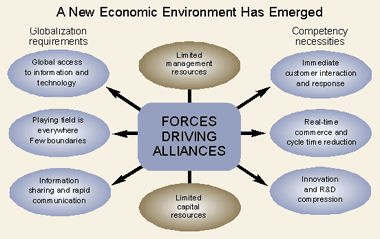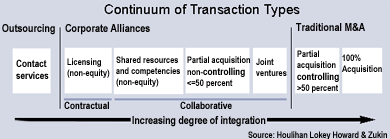MARKET WATCH
The concept of companies working together to deliver products or services isn't new. What's changing, however, is the nature and scope of corporate alliance arrangements, reflecting the explosion of this business tool across nearly all industry categories.
The concept of companies working together to deliver products or services isn't new. What's changing, however, is the nature and scope of corporate alliance arrangements, reflecting the explosion of this business tool across nearly all industry categories. Aerospace and defense and government services companies have used "prime-sub" relationships and other teaming arrangements as staples of business strategy. However, the emerging array of alliance arrangements offers greater potential to reach across markets, geography and political boundaries to expand technology application and capitalize on business opportunities. For tier-one industry companies, this provides an opportunity to achieve double-digit growth in a single-digit global market. Consider these facts: Worldwide, more than 20,000 alliances have been established in the past 24 months. In the United States alone, more than 7,000 were completed, of which nearly 2,000 were joint ventures or involved equity investments by the parties. Worldwide, the average investment in these equity joint ventures was $70 million, with a lower average in the United States of approximately $50 million. In addition, the number of corporate alliances is growing 25 percent per year, with no sign of abatement. For the top 1,000 U.S. companies, it is expected that by 2004, 30 percent of their revenue will come from alliances. Considering the dynamics of today's business environment, experts conclude that these trends are likely to continue and possibly accelerate. Why? Very simply, corporate alliances provide the vehicle for companies large and small to address the challenges in the global economy in a timely fashion, while protecting and, usually, harvesting valuable intellectual property. Bottom line, these arrangements accelerate revenue growth, increase return on investment and, coincidentally, reduce business risk. That's quite a combination. Typically, this combination drives a company's stock price higher, often much higher. Here I've summarized some of the attributes and advantages of these corporate alliance tools.There are a variety of corporate alliances. Where alliances fit is depicted below along the continuum of transaction types, between outsourcing (contract services) and traditional mergers and acquisitions (controlling or complete acquisition). Corporate alliances can range from licensing (non-equity) through joint ventures, with equity components. Alliance governance models include product partnerships, joint innovation partnerships and solution alliances. Governance arrangements are negotiated on a case-by-case basis relative to partner contributions, market circumstances and other factors. Strategy formulation and execution plans are, likewise, developed to fit the circumstances. Clearly, the goal of finalizing a sound, profitable alliance requires in-depth understanding of the issues to be addressed and a comprehensive process to progress from identification of prospective partners to effective execution.Business today is more complex than in years past. Among the reasons for this are the rapid pace of technological change and, more specifically, the necessity that businesses deploy emerging technologies, often revising their business structures in the process. Recruiting and training must be adjusted to provide the people needed to make these evolved businesses successful. The data indicate that businesses in the United States are lagging behind in the art of alliance-making. To some extent this is logical, as the United States is the largest market in the world for business goods and services. Domestic companies have sensed less of a need to form alliances until recently. Globalization of both technology and markets has driven home the conclusion that companies cannot go it alone. This conclusion is not a sign of weakness, but rather a reflection of business realities. Companies that have publicly confirmed their belief in the need for alliances include Microsoft Corp., Oracle Corp. and General Motors. Major domestic aerospace and defense companies have been very active in recent years, including Lockheed Martin Corp., Raytheon Corp. and the Boeing Co., among others. Major European aerospace and defense firms (tier one companies) have more often used corporate alliances to gain technology, critical mass in programs and capabilities and access to target foreign markets. BAE Systems, Thales, EADS, Finmeccanica and many others have deployed corporate alliances frequently and effectively.Increasingly, tier-two, middle-market companies are considering alliances as the right tool to expand their capabilities, to harvest intellectual property and to grow value. Well-conceived and implemented corporate alliances are very positive. At a minimum, getting a better understanding of these tools is imperative.



Jerry Grossman is managing director at Houlihan Lokey Howard & Zukin in McLean, Va.

Jerry Grossman


Jerry Grossman is managing director at Houlihan Lokey Howard & Zukin in McLean, Va.
NEXT STORY: Government Leads IT Spending

